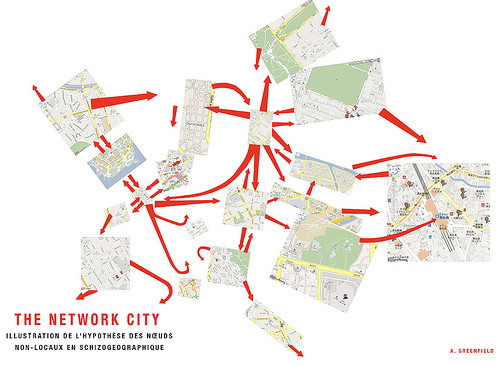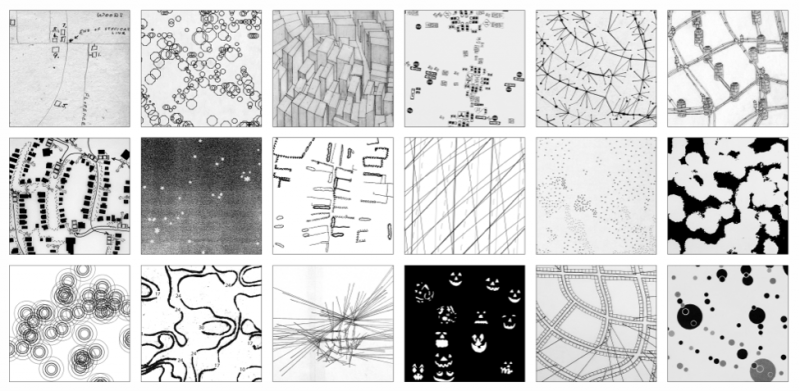Introduction, II: Making a Turn

The arrows that traverse Adam Greenfield’s “The Network City” not only pay homage to Debord and Jorn’s “The Naked City” but also suggest a cluster of arguments that grow increasingly persuasive as counter-mapping enters the digital age. As the columns in the second half of this series will suggest,
- counter-maps aim to capture not static states but events, actions, energies, and flows;
- the terrain they make visible is a swarm of exits and entrances, breached borders, incursions, escapes, and escapades;
- because this territory is understood to be multiple, abundant, heterogeneous, and layered, counter-maps thrive on collective or collaborative composition and public debate;
- and, finally, although most counter-maps composed since 1995 rely on computational and algorithmic procedures to encode, present, distribute, and analyze data, they are best understood as humanistic documents, documents in which, in Johanna Drucker’s words, “interpretation, ambiguity, inference, and qualitative judgment take priority over quantitative statements and presentations of ‘facts’” (“Overview,” n.p.).
In focusing on an array of post-1995 projects, we join two previous Jacket2 commentaries that also scan for new poetic modes and models. Concluding the tenth column in his series, Barrett Watten writes, “We need larger frameworks for poetics . . . [frameworks] that produce, rather than merely reproduce, the knowledge practices, affects, and objects that in their new combinations will indelibly mark our time.” In the first column of their series, Jasper Bernes, Joshua Clover, and Juliana Spahr speculate that “the revolutionary formation of a free and equal society would mean not only the end of poets but also poems, allowing for some new form of aesthetic expression that might still deserve the name poetry.” Our contribution to this discussion follows Debord and Jorn’s arrows toward another use of contemporary knowledge practices to generate “some new form of aesthetic expression that might still deserve the name poetry.”
In the columns that follow, most of the counter-maps—although, importantly, not all—originate in pixels, not on paper. A few may have been, like Debord and Jorn’s maps of Paris, cut, pasted, and collaged from municipal tourist materials or, like Denis Wood’s maps of Boylan Heights, North Carolina, sketched with pencil and pen, but most were made by creating and combining layers of data collected by networks of satellites and ground stations originally developed for military surveillance. Using GPS, GIS, remote sensing satellites, and APIs—that is,
- Global Positioning Systems accessible to anyone with a smartphone, camera, Bluetooth device, or handheld receiver;
- Geographical Information Systems tools that map, model, query, and analyze large quantities of data in a single database;
- comprehensive imagery obtained over decades by a network of government, military, and private remote sensing satellites capable of zooming into virtually any location on earth from a position 400 miles in the sky to detect and represent surface structures as small as fifty centimeters (Kurgan 21);
- and Application Programming Interfaces constructed by sites such as Google Earth, OpenStreetMap, and HyperCities to enable code-savvy users to access, analyze, and transform data stored in their databases
—contemporary counter-mappers crunch spatial, temporal, social, and historical data into documents with ethical, political, and, we believe, poetic stakes.
Our argument here is not technologically determined: although the affordances of GPS, GIS, remote satellites, and API set the bells and whistles of recent counter-maps, they do not call the tune.
Just as William Bunge and his crew of Detroit teenagers worked from municipal records of accidents and reports of rat bites, Denis Wood and his students drew on online historical data, aerial imagery, and Google Street View images of Boylan Heights. “But,” Wood continues, importantly, such information is “all disaggregated, inchoate. Something’s missing, maybe the poetry” (Everything 29). What gives counter-maps their distinctive pattern is not, for Wood, “the new technologies with their satellites, their gazillion miles of optical fiber, their computer hardware, and their miraculous software (that is . . . their extraordinary capitalization)” but rather “the new attitudes, visions, and radical philosophies of the counter-mappers” (Rethinking 111).
Like Bernes, Clover, and Spahr, who pin the genre of poetry back to “the coronation of kings, the praise of nations, the vindication of the ways of god (or the gods) to man, [and] the counting and administration of the wealth of the rulers” (“Self-abolition”), Wood positions maps as administrative instruments designed to convert social energy into social order through “[t]he ceaseless reproduction of the culture that brings [them] into being” (1). Set up by local, state, and national governments, regulated and enforced by the courts, the police, and, in extreme situations, the military, maps establish ownership, set borders, and configure zones for taxation, voting, school attendance, housing, and commerce. “Once a map has been published,” Wood concludes, “it is pretty much taken for a description of the way things actually are. . . . The map’s propositional character becomes . . . hard to see” (Rethinking 2-4, second ellipsis in text).
To borrow the Situationists’ term for what Wood calls “attitudes, visions, and radical philosophies,” counter-maps détourne—hijack, divert, misappropriate—official cartographic instruments and protocols: they use what Wood calls “a poetics of cartography” (Everything 19) to expose the fact that maps—along with the data sets and technologies used to chart them—are not neutral: they have designs on how we live and what we do. As Hakim Bey puts it, more pungently, a “‘map’ is a political abstract grid, a gigantic con enforced by the carrot/stick conditioning of the ‘Expert’ State, until for most of us the map becomes the territory. . . . Hidden enfolded immensities escape the measuring rod. The map is not accurate; the map cannot be accurate” (101).
In 2013, Wood and his students published a compendium of counter-maps under the title Everything Sings: Maps for a Narrative Atlas. Its frontispiece is a sheet of 18 maps of Boylan Heights, a residential subdivision of Raleigh, North Carolina:

Bordered by North Carolina’s maximum security prison for men on one side, the state’s central psychiatric hospital on another, and, on a third, a cement factory and railroad line, these redrawn maps show Boylan Heights to be not just a Deleuzian society of control or feeder for a Fordist industrial zone but also, and importantly, if not a utopia something like one of Bey’s “temporary autonomous zone[s]”: a non-hierarchical space exhibiting the potential of potential, a virtual space that belongs to multiple alternative local ecologies.
Wood and his students map the night sky visible above Boylan Heights’ main intersection, the city’s geological substructure with intruded arteries (water mains, gas lines) and veins (sewage pipes), pools of light spilled at street corners, zones of sound constructed by wind chimes and barking dogs, squirrel highways strung between poles carrying electricity and information out of and back into national and international communication grids, paper routes bringing in The Raleigh Times and garbage routes carrying the daily paper to the dump, sidewalk graffiti, a ballet of bus routes, and jack-o’lanterns set out on porches. The agenda of these maps, as Wood’s readings demonstrate, is to make alternative epistemological and ontological patterns as real as any other facts about Boylan Heights.
You can’t click these maps, zoom them, add additional layers of data with a keystroke, or instantly annotate them, but—and this is perhaps the stubbornness in volume’s DIY drawings—you can turn the page or, better, pick up your own pencil for parallel effects and, as his title suggests, lyric and narrative affects. “This has made it into the book you’re holding in your hands,” Wood writes: “a collection of maps as a poem, or perhaps fragments of a much longer poem out of which a passable semblance of the whole has been reconstructed” (Everything 21)
The commentaries in the second half of this survey ask two large questions:
- How is 21st-century counter-mapping related to the radical practices of the classical avant-garde?
- In what way is the contemporary counter-mapping culture at once constrained and enabled by technologies developed by states and corporations for purposes of control, surveillance, and military maneuvers in a global theater of multinational contention and crisis?
The five rough divisions to come—forensic maps, embodied or locative maps, protest maps, memory maps, and eco-maps—have been chosen from a range of emergent alternatives to offer a glimpse into both the poetics of cartography and a cartographics of contemporary poems.
This matters because, as Wood insists, maps are about complicity: they show what we agree to agree is the way things are. This entails, as he emphasizes, an ethics of civic, environmental, and global responsibility: “When someone drops a bomb on something and kills a bunch of kids,” Wood explains to an interviewer, “and they do that using a map that you made, you either accept the responsibility for it—a kind of well, you can’t make an omelet without breaking some eggs responsibility—or you say, ‘Damn it, I can’t do this anymore’” (Everything 134).
The counter-maps in the columns-to-come provide what geographer Laura Kurgan calls “a certain intimacy” with the technologies of the knowledge practices that surround us. They allow, that is, “an encounter with their opacities, their assumptions, their intended aims” (14) that not only foregrounds their ethical and political stakes (14) but suggests some of their implications for contemporary poetic practice.
Works Cited:
Bernes, Jasper, Joshua Clover, and Juliana Spahr. “The self-abolition of the poet.” http://jacket2.org/commentary/self-abolition-poet
Bey, Hakim. T.A.Z.: The Temporary Autonomous Zone, Ontological Anarchy, Poetic Terrorism. 2nd edition. Brooklyn, NY: Autonomedia, 2003.
Drucker, Johanna. Graphesis: Visual Forms of Knowledge Production. metaLABprojects. Cambridge, MA: Harvard University Press, 2014.
Greenfield, Adam. The Network City. Map. http://www.flickr.com/photos/studies_and_observations/3999248192/
Kurgan, Laura. Close Up at a Distance: Mapping, Technology, and Politics. New York: Zone Books, 2013.
Presner, Todd, David Shepard, and Yoh Kawano. Hypercities: Thick Mapping in the Digital Humanities. metaLABprojects. Cambridge, MA: Harvard University Press, 2014.
Watten, Barrett. “Entry 10: The selfie as poetics.” http://jacket2.org/commentary/entry-10
Wood, Denis. Everything Sings: Maps for a Narrative Atlas. Second edition, revised & expanded. Siglio: Los Angeles, CA, 2013.
--------, with John Fels and John Krygier. Rethinking the Power of Maps. New York: The Guilford Press, 2010.
Counter map collection